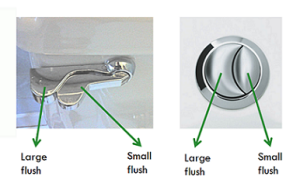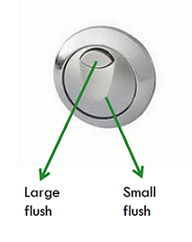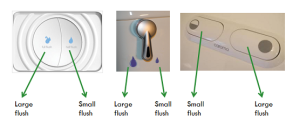Often, water savings happen during the most mundane of daily tasks: taking a shower, washing dishes, brushing teeth. Changing the way that we do these routine activities can have a big impact on the environment. Currently, you probably don’t devote a lot of thought to flushing the toilet. But 30% of household water is used in toilets, so your flushing habits have a lot of potential for water savings. As part of our project to rehabilitate the Jordan River, Friends of the Earth Middle East (FoEME) has researched how the correct use of double flush toilets can save water.
Also called “dual flush,” double flush toilets are equipped with a lever or set of buttons that allows users to choose between two water settings. A larger flush, usually about 6-9L, is designed for solid waste, and a smaller flush, usually about 3-4.5L, is designed for liquid waste. By using a smaller flush when possible, double flush toilets generate water savings. A double flush toilet can save 20,000 L of water each year compared to a single flush toilet. That is about the same amount of water used for a family-sized swimming pool.
Double flush toilets are becoming increasingly common in Jordan, Israel, and Palestine—good news for our water-scarce region. You’ll find them in restaurants, hotels, and even the homes of your family and friends. However, you must use double flush toilets correctly in order to save water. There are many different designs of double flush toilets on the market, and buttons and levers come in all shapes and sizes. It can be difficult to figure out which button or lever to use, so FoEME offers a few tips to help minimize confusion.
Tip #1: Look at the size of the buttons or levers. Most small buttons indicate a small flush, and most large buttons indicate a large flush. The photos below give some examples:
However, the small button actually triggers a large flush in some cases. If the small button is completely inset inside the large button, it indicates a full flush, as in the example below.
Tip #2: Look at the images on the buttons or levers. For example single rain drop indicates small flush, while several rain drops are for a large flush. Similarly, a half or small circle triggers a small flush, while a full or large circle is for a large flush.
Before each use of a restroom in a new place, pay attention to the buttons or levers to make sure you use double flush toilets correctly.
By implementing water saving measures and decreasing demand for water in the region, our water supply will be less strained and natural resources like the Dead Sea and Jordan River will experience less exploitation. Great impact can come from a simple flush.
– This post was contributed by FoEME intern Emily Hylton. Emily is based in FoEME’s Amman office.


